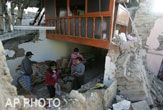Peru Quake Aftershocks Could Last Months

Updated at 2:45 p.m. Eastern
The 8.0-magnitude earthquake that shook Peru's coast last night, killing at least 450 people, is expected to continue generating powerful aftershocks for weeks or even months, a U.S. Geological Survey geophysicist says.
Today, officials upped the earthquake's magnitude from 7.9 to 8.0, a significant jump as the scale is logarithmic.
"We've had a number of aftershocks, some in the magnitude-6 range," said seismologist Harley Benz of the USGS National Earthquake Information Center in Colorado. "This is expected for these large earthquakes like this. We will likely be recording aftershocks from this event weeks and months from now."
Lasting about two minutes, the earthquake occurred Wednesday, Aug. 15, at about 6:40 p.m. local time (7:40 p.m. Eastern Daylight Time), near the coast of central Peru, 95 miles (150 kilometers) from Lima. The epicenter was located about 20 miles (30 kilometers) beneath Earth's surface, rupturing a fracture that extended 62 miles (100 kilometers).
The quake occurred at the boundary between the Nazca and South America tectonic plates, which have been converging at a rate of three inches per year. As the two rocky plates collided and caused the temblor, the Nazca plate dove beneath the South American plate, a phenomenon called thrust-faulting.
(California's San Andreas Fault zone is considered a strike-slip fault as rocky plates slide horizontally past each other.)
Sign up for the Live Science daily newsletter now
Get the world’s most fascinating discoveries delivered straight to your inbox.
And though the latest Peru temblor caused significant damage, the event doesn't strike scientists as unique. "This earthquake really wasn't that unusual for this part of South America, particularly the coast of Peru," Benz told LiveScience.
The quake that rocked Lima last night was deadlier than a 7.5-magnitude quake that struck Peru just two years ago. The smaller scale of damage in the 2005 quake was likely due to the fact that its epicenter was in a more remote location.
The death rate for last night's quake would have been even greater if the epicenter had been closer to Peru's capital. "In this case, based on the modeling we've done, Lima, the capital, experienced an intensity of around 6, so about 7 million people suffered from strong ground-shaking," Benz said. "Had this earthquake been closer to Lima than it was, we may have expected more damage."
An 7.9-magnitude quake struck Peru on May 31, 1970, killing 66,000 people.
In fact, a significant number of the world's earthquakes occur in these so-called subduction zones where one plate gets shoved beneath another, including the devastating Indian Ocean quake of 2004 that struck off the coast of Sumatra the day after Christmas. Together, with the massive tsunami waves it generated, the quake killed more than a quarter of a million people.
Last night's 8.0-magnitude earthquake generated 33 times less ground-shaking energy than the 2004 Sumatran quake, measuring 9.0 in magnitude, Benz said. Plus, the ruptured Peruvian fault was on the order of 10 times smaller than the Sumatran fault zone, which extended about 500 miles (800 kilometers).
The deadliest earthquake of all time was an estimated 8.0-magnitude quake that struck Shansi, China, in 1556 and killed an estimated 830,000 people.
- The Big Earthquake Quiz
- Natural Disasters: Top 10 U.S. Threats
- Images: Deadly Earthquakes
Jeanna Bryner is managing editor of Scientific American. Previously she was editor in chief of Live Science and, prior to that, an editor at Scholastic's Science World magazine. Bryner has an English degree from Salisbury University, a master's degree in biogeochemistry and environmental sciences from the University of Maryland and a graduate science journalism degree from New York University. She has worked as a biologist in Florida, where she monitored wetlands and did field surveys for endangered species, including the gorgeous Florida Scrub Jay. She also received an ocean sciences journalism fellowship from the Woods Hole Oceanographic Institution. She is a firm believer that science is for everyone and that just about everything can be viewed through the lens of science.












